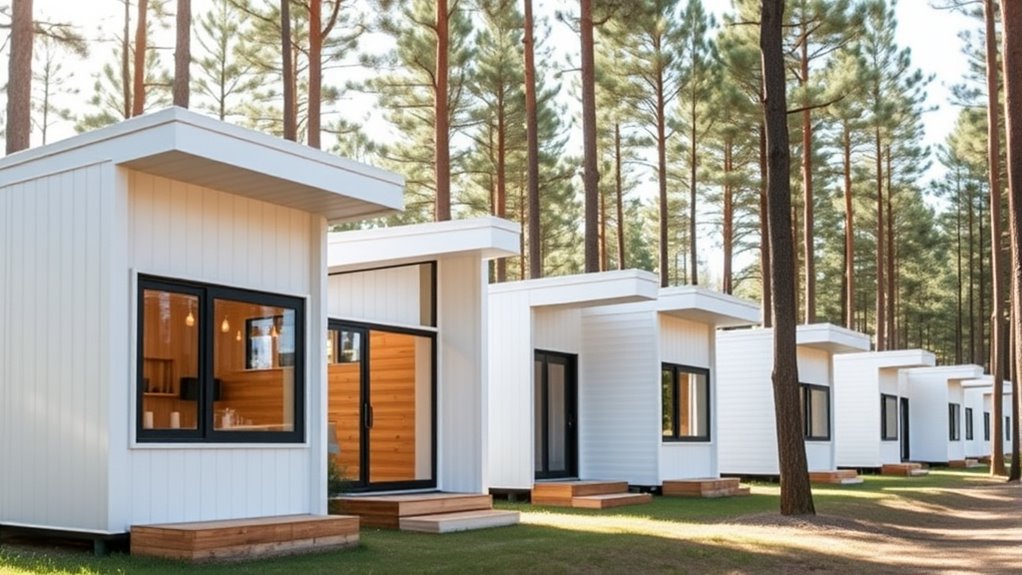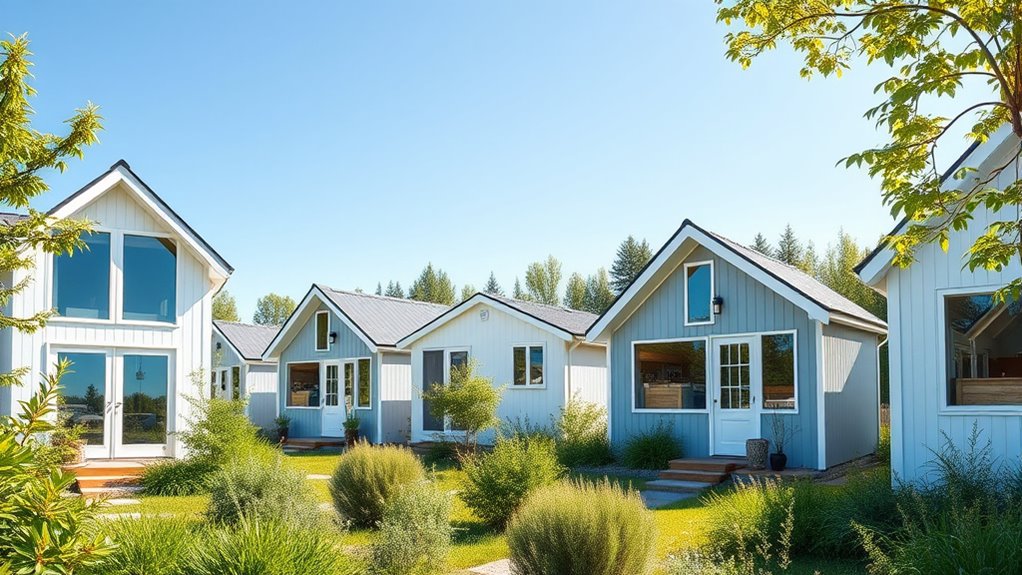Scandinavian-inspired tiny houses are gaining popularity for their sleek design, minimalist aesthetics, and eco-friendly approach. You’ll notice clean lines, neutral tones, and natural materials that create calming, functional spaces. These homes maximize small footprints with clever storage solutions, multi-purpose furniture, and open layouts. Emphasizing sustainability, they use reclaimed materials and large windows for natural light, promoting responsible living. Stay with us to explore how these stylish, eco-conscious designs are transforming tiny living.
Key Takeaways
- Scandinavian-inspired tiny houses emphasize minimalism, clean lines, and functional design to create calming, modern living spaces.
- They utilize sustainable materials like reclaimed wood and eco-friendly finishes to promote environmental responsibility.
- Open floor plans and multi-purpose furniture maximize space efficiency in small footprints.
- Natural light through large windows and skylights enhances interior brightness and energy efficiency.
- The design prioritizes simplicity, practicality, and timeless aesthetics aligned with Nordic principles.

In recent years, Scandinavian-inspired tiny houses have gained popularity for their sleek design, functionality, and minimalism. You’re drawn to their clean lines and uncluttered aesthetic, which feels both calming and modern. These homes emphasize simplicity, making the most of limited space without sacrificing style. The key lies in their minimalist design—every element serves a purpose, with little to no excess. You’ll notice how open floor plans and clever storage solutions create a sense of spaciousness, even in a small footprint. This approach isn’t just about looks; it’s about making life easier and more organized. The focus on minimalist design means you avoid unnecessary clutter, allowing you to enjoy a serene environment that promotes relaxation and clarity.
What truly sets these tiny houses apart is their commitment to sustainability. They are built using sustainable materials, reducing environmental impact while offering durability and beauty. You might find reclaimed wood, recycled metal, or eco-friendly insulation integrated into their construction. This conscious choice of materials doesn’t just benefit the planet—it also enhances the home’s aesthetic appeal. The natural textures and tones of sustainable materials give the interior a warm, inviting feel that complements the minimalist design. You’ll find that these tiny homes often incorporate large windows and skylights, maximizing natural light to reduce energy consumption and create a bright, airy atmosphere. The use of sustainable materials aligns with a broader lifestyle that values eco-conscious living, allowing you to reduce your carbon footprint without compromising comfort or style.
Inside, the design emphasizes functionality. Every piece of furniture is carefully chosen to maximize space and usability. Multi-purpose furniture, built-in storage, and fold-away features are common, helping you make the most of every square inch. The interiors are often neutral in color, with pops of muted tones that add visual interest without overwhelming the senses. This simplicity fosters a peaceful environment where you can unwind easily. The use of sustainable materials extends to fixtures and finishes, which are selected not only for their eco-friendly qualities but also for their timeless appeal. All these elements combine to create a home that’s both beautiful and responsible, reflecting the Nordic ideals of form meeting function.
Frequently Asked Questions
What Are the Cost Differences Between Tiny Houses and Traditional Homes?
You’ll find that tiny houses generally cost considerably less than traditional homes, making them a smart option for budget planning. The cost comparison shows lower upfront expenses, including land, construction, and maintenance. However, consider potential hidden costs like permits or renovations. Overall, tiny houses offer an affordable alternative, helping you save money, while traditional homes might require a larger investment but offer more space and long-term stability.
How Do Scandinavian-Inspired Tiny Houses Perform in Different Climates?
You might worry about climate adaptation, but Scandinavian-inspired tiny houses excel thanks to their superb insulation effectiveness. In cold climates, their high-quality insulation keeps heat in, reducing energy costs. In warmer areas, smart ventilation and natural materials help maintain comfort. These homes are versatile, adapting well across diverse climates, making them a practical choice regardless of where you live. Their design guarantees comfort and efficiency year-round.
Are There Specific Building Codes for Tiny Houses in Scandinavia?
You should know that building code variations and zoning restrictions differ across Scandinavian countries, so it’s crucial to check local regulations before constructing your tiny house. In some areas, codes may be more flexible, allowing innovative designs, while others have strict rules on size, insulation, or utility connections. You’ll need to consult local authorities or a professional to make sure your tiny house complies with all specific building codes and zoning restrictions.
What Are the Most Popular Interior Design Elements in These Tiny Homes?
You’ll love the minimalist aesthetics and natural materials that define these tiny homes, as over 75% feature sleek, clutter-free interiors. You’ll notice light wood accents, neutral tones, and functional furniture that maximize space without sacrificing style. These design elements create a cozy, airy atmosphere that promotes calm and simplicity, making your small living area feel spacious and inviting. It’s all about blending practicality with Scandinavian elegance.
How Sustainable Are Materials Used in Scandinavian-Inspired Tiny Houses?
You’ll find that sustainable materials in Scandinavian-inspired tiny houses are highly eco-friendly, supporting eco-friendly construction practices. These homes often use responsibly sourced wood, recycled metals, and non-toxic finishes, reducing environmental impact. By choosing sustainable materials, you help lower your carbon footprint and promote healthier living environments. Many designers prioritize eco-conscious choices, ensuring your tiny house remains both stylish and environmentally responsible, aligning with the minimalist, nature-inspired aesthetic you value.
Conclusion
As you embrace the Scandinavian-inspired tiny house movement, remember that, like the Vikings sailing into new horizons, you’re venturing into a minimalist future rooted in simplicity and functionality. These homes don’t just save space—they invite you to live intentionally, appreciating clean lines and cozy comfort. So, as you step into your tiny sanctuary, know that you’re part of a modern voyage—crafting a lifestyle that echoes the timeless Scandinavian spirit of innovation and serenity.







